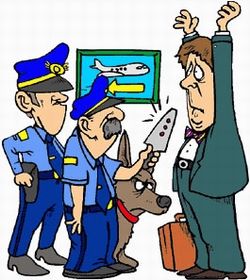Wed, Aug 05, 2009
They Say It Protects The Privacy Of The Traveling Public
 TSA announced Monday that it will
begin testing backscatter advanced imaging technology at Greater
Rochester International Airport. Imaging technologies quickly and
unobtrusively screen passengers for metallic and nonmetallic
threats without physical contact.
TSA announced Monday that it will
begin testing backscatter advanced imaging technology at Greater
Rochester International Airport. Imaging technologies quickly and
unobtrusively screen passengers for metallic and nonmetallic
threats without physical contact.
Backscatter imaging technology provides enhanced detection
capabilities and is 100 percent optional for all passengers.
Privacy protections are in place for the traveler. The security
officer who assists the passenger through the screening process
never sees the image the technology produces. The image is viewed
by a remotely located security officer who never sees the traveler.
Further, these technologies cannot save, print, or transmit images.
Once the image is deleted it cannot be restored. To further protect
passenger privacy, TSA is testing backscatter technology with an
algorithm applied to the entire image.
 "We are looking forward to testing this new technology," said
John McCaffrey, Federal Security Director Greater Rochester
International Airport, Transportation Security Administration.
"This is an additional layer of security that gives our officers
the tools to detect threats and has privacy protections built in
for the traveling public."
"We are looking forward to testing this new technology," said
John McCaffrey, Federal Security Director Greater Rochester
International Airport, Transportation Security Administration.
"This is an additional layer of security that gives our officers
the tools to detect threats and has privacy protections built in
for the traveling public."
Backscatter technology uses low-level X-ray and a single scan is
the equivalent of flying on an airplane for approximately two
minutes. This technology produces an image that allows TSA to
remotely screen the passenger for threats without physical contact.
It is safe for all passengers.
At Rochester, TSA will assess the operational efficiency and
public acceptance of backscatter technology as the primary
screening technology in lieu of the traditional metal detector.
Imaging technology not only enhances security, it reduces the need
for pat-down searches for passengers with joint replacements and
other medical conditions.
TSA says imaging technology is a critical layer of security that
enables them to screen passengers for a wide range of threats while
maintaining passenger privacy. Layers of security, like this one,
are integrated to mitigate risk and ensure the safety of the
traveling public, they say.
More News
Also: B-29 Superfortress Reunion, FAA Wants Controllers, Spirit Airlines Pulls Back, Gogo Galileo Van's Aircraft posted a short video recapping the goings-on around their reorganiz>[...]
Light Gun A handheld directional light signaling device which emits a brilliant narrow beam of white, green, or red light as selected by the tower controller. The color and type of>[...]
"The journey to this achievement started nearly a decade ago when a freshly commissioned Gentry, driven by a fascination with new technologies and a desire to contribute significan>[...]
"Our driven and innovative team of military and civilian Airmen delivers combat power daily, ensuring our nation is ready today and tomorrow." Source: General Duke Richardson, AFMC>[...]
Aircraft Conflict Predicted conflict, within EDST of two aircraft, or between aircraft and airspace. A Red alert is used for conflicts when the predicted minimum separation is 5 na>[...]
 Airborne 04.16.24: RV Update, Affordable Flying Expo, Diamond Lil
Airborne 04.16.24: RV Update, Affordable Flying Expo, Diamond Lil ANN's Daily Aero-Term (04.20.24): Light Gun
ANN's Daily Aero-Term (04.20.24): Light Gun Aero-News: Quote of the Day (04.20.24)
Aero-News: Quote of the Day (04.20.24) Aero-News: Quote of the Day (04.21.24)
Aero-News: Quote of the Day (04.21.24) ANN's Daily Aero-Term (04.21.24): Aircraft Conflict
ANN's Daily Aero-Term (04.21.24): Aircraft Conflict




